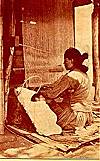

Contributions to the Arts and Crafts
Introduction
The indigenous peoples of the Southwest are from a number of distinctive cultures. From the Pueblo cliff dwellers to the nomadic Plainsman, the Native Americans of the region have fascinated outsiders interested in discovering the American Southwest. These visitors hoped to discover for themselves this other way of being, seemingly more simple, less hectic than what Anglo-American society offered. Particularly attractive was the fact that the Native American cultures had complex religious beliefs and ceremonies as well as skilled artisans. These artisans created beautifully crafted pieces, some tied to their distinctive rituals while other pieces were created from skills learned from other cultures.
For example, the Navajos learned weaving from the Pueblo Indians and silversmithing from the Spanish. Interestingly, the first collectors of Indian arts and crafts were other Indians. Pieces by these artistic weavers, potters, basketmakers and silversmiths were highly valued and desired. As the eastern Anglo-Americans' interest peaked about the Southwest and the Indian populations, so did the opportunity for selling indigenous artifacts.
In the mid 1870's, government licensed traders could operate trading posts on Indian Reservations. Lorenzo Hubbell established the first trading post on the Navajo Indian Reservation at Ganado, Arizona in 1878, becoming the best known trader and leading rug dealer in Arizona. Lorenzo, who sold Indian products, often stated, "A good Navajo blanket is better than having money in the bank." Other traders and dealers soon followed: John B. Moore at Crystal, New Mexico; Richard Wetherill of Chaco Canyon, New Mexico; Babbitt Brothers Trading Company at Flagstaff, Arizona; and the famous Fred Harvey, who established shops and hotels along the Santa Fe Railroad line, featured Indians handicrafts for purchase by the traveler, curio collector or museum.
By the late 1800's and early 1900's, Indian traders and dealers were circulating souvenir pamphlets and mail-order catalogues that advertised Indian merchandise for sale. These pieces were guaranteed to be handmade and genuine. Dealers, also known as boosters, even promised special orders of Indian crafted objects that were compatible with eastern decor. Soon the demands of Anglo-American tastes and preferences coupled with economic pressures influenced the designs, colors and types of Indian handicrafts produced, but the traditional process and tools remained unchanged.
Featured here are examples of some of the brochures, souvenir pamphlets
and catalogues used by traders, dealers, railroad companies, government
agencies, and others as promotional strategies arts and crafts.
In order to view the following files you must have an Acrobat Reader.
If you do not possess this software please consult the
About
the PDF link.
To view a larger color image of one page of the pamphlet in JPEG, click on any image thumbnail. To view the whole pamphlet as PDF (color or black-and-white), click on the linked call number next to the thumbnail.
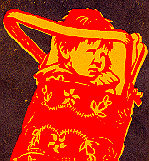 Robert E. Ritzenthaler
Robert E. Ritzenthaler
Indian Cradles. Lore Leaves 1. Reprinted from Lore 1:2
[Milwaukee]: Wilwaukee Public Museum
Circa 1950 (Second Printing), 8 pages
I9791
Pam. 40 [1.8 MB]
In this reprint from Lore, Ritzenhaler addresses Indian cradles: the names, purposes, types, styles, traditions, and differences in cradles among various North American tribes. Photographs and illustrations of cradles by Kwakiutl, Hopi, Pomo, Chippewa, Paiute, Sioux, and Chinook accompany the text. The publication provides a short bibliography as well as advertisements on additional publications produced by the Milwaukee Public Museum.
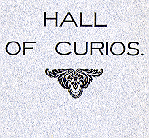 Babbit Bros
Babbit Bros
Hall of Curios.
Photographed and compiled by L.F.F.
Flagstaff: C.M. Funston, Printer
Circa 1900s, 12 pages
I9791.N31
Pam. 6 [1.7 MB]
This Babbitt Brothers' promotional brochure describes various "Indian industries" such as: blankets, basketry, pottery, silver work, and relics. Aside from a particular emphasis on Navajo weaving and silver work, the author largely speaks in general terms about other Indian crafts, making brief references to Zuni, Pueblo, and Moqui pottery and to Mojave bead work. The brochure provides black and white photographs of many of the crafts available in the Hall of Curios.
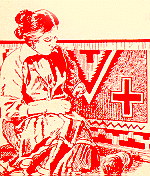 Cedar Ridge Trading Post Company
Cedar Ridge Trading Post Company
Indian Designs
[Cameron, Arizona]
Circa 1950s, 1 folded sheet
Vertical
File Indians--Navajo Indians--Arts and Crafts [0.1 MB]
"Out of a remote past has been handed from generation to generation among the Southwestern Indians a group of symbolic designs used in decoration and ceremony." So begins this small tri-fold pamphlet printed in red, white and black which graphically details numerous "Indian symbols and their meanings as interpreted by modern Indian craftsmen." In addition to a chart of Indian symbols, the pamphlet contains two narratives about the Navajo Rugs and Indian Jewelry and relate the process in brief of creating these crafts.
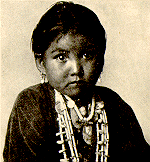 Indian Symbols
Indian Symbols
Circa 1950s, 1 folded sheet
Vertical File Indians [0.1 MB]
This brief pamphlet provides a table of "Indian Symbols" and their meanings which "are found in the decorations of ceremonial altars and the designs of Pottery, Baskets and Blankets and are used in Indian Design Silver."
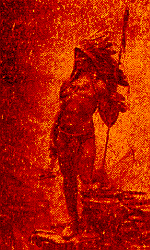 R. M. Bruchman
R. M. Bruchman
Facts About the Navajos
Winslow, Arizona
October 1923, 16 pages
I9791.N31
Pam. 15 [3.8 MB]
In Facts About the Navajos, R.M. Bruchman, a trading post proprietor, along with an unnamed writer depict from their viewpoint various aspects of Navajo Indian history, social customs, communal life, weaving and language.
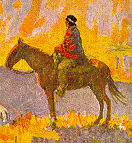 United States Railroad Administration
United States Railroad Administration
Arizona and New Mexico Rockies
Chicago: Rand McNally and Co.
[1919], [2],46 pages
C9791
Pam. 208
Partial pamphlet [2.5 MB]
Zane Grey's introduction stimulates the human senses by his vivid description of Arizona and New Mexico. Whether by railroad, motor car or horseback, any curious traveler would be convinced they must experience the numerous sights and adventures depicted in this picturesque travel brochure, from the cliff dwellings of the Indian Pueblos to the Colorado River in the Grand Canyon.
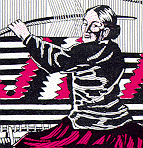 Francis E. Lester
Francis E. Lester
The Indian Blanket. Lester Handicraft Talk 1:1
[Mesilla Park, New Mexico]
1907, 16 pages
Vertical
File Indians--Pueblo Indians--Textile Industry and Fabric [2 MB]
From the front cover to the last page, this eye-dazzling catalogue promises the customer it all -- the most exquisite, durable and economical blanket or rug anywhere, including special orders for any desired size, color and design. Mr. Lester assures the buyer that no imitation product will be sold due to his direct supervision over the Indian weavers and his personal inspection of their handicrafts and in addition, all merchandise "sold by us bears under seal our positive warranty of genuineness."
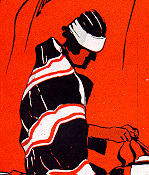 [Inter-Tribal Indian Ceremonial Association]
[Inter-Tribal Indian Ceremonial Association]
Gallup, New Mexico Inter-Tribal Ceremonial
[Gallup, New Mexico]
1926, 4 pages
E78.S7
I57 Pam. [2.2 MB]
Indians on the front cover crossing the mountains on horseback invite the public to witness 14 different tribes, performing over 40 ceremonial dances before they, the Indian, become extinct. The 5th annual ceremony appears to be a joint promotional endeavor by both the "white" and "red" man, but for different purposes: the Indians' aspiration to preserve their cultural heritage, and the Santa Fe Railroad's and hotels' desire for financial profit.
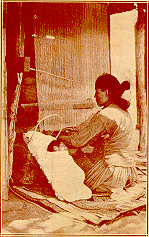 [Drolet Trading Post]
[Drolet Trading Post]
The Story of the Navajo Rug
[Tohatchi, New Mexico]
1933, 1 folded sheet
Vertical File Indians--Navajo Indians--Textile Industry and Fabric [0.1 MB]
"A Weaver at Her Loom " identifies the image of the Indian woman with her infant child at her side, squatting as she tediously, but skillfully weaves and creates her traditional Navajo rug. According to the brochure she is know as Yis-clo-yazzi (Little Weaver) who learned to weave as a little girl and now if you, the buyer, purchase her artistic product as a souvenir or gift from Drolet Trading Post then, "you are directly encouraging the arts and crafts of the original American."
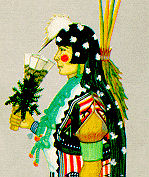 New Mexico State Tourist Bureau
New Mexico State Tourist Bureau
The Arts and Crafts of New Mexico Indians
[Santa Fe, New Mexico]
[After 1956], 1 folded sheet
Vertical File Indians--New Mexico--Arts and Crafts Partial pamphlet [2.6 MB]
This colorful pamphlet presents a brief, but accurate overview of the Indians artists of New Mexico, highlighting important historical facts, traditions and techniques that not only influence the artisans' work but also explain why these skilled professionals excel as painters, weavers, potters and silversmiths. The New Mexico State Tourist Bureau also provides educational documentation about the various Indian tribes, including their population, language, religion, reservations and pueblos, government, and points of interest for the traveling tourists.
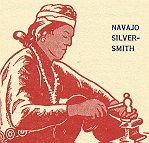 [Fred Harvey]
[Fred Harvey]
Indian and Mexican Handicraft
[Albuqerque, New Mexico]
Circa 1945, 4 pages
Vertical
File Fred Harvey Company (Santa Fe Dining Car Services and Hotels) [82 KB]
Examples of southwestern handicrafts decorate the brochure provided by entrepreneur Fred Harvey for "the Santa Fe travelers and for the purpose of promoting a greater appreciation of the native products of the Southwest". Travelers could purchase these authentic hand-made collectibles from the Harvey collection either on the Santa Fe train, at the Indian Building in Albuquerque, the Indian Shop in Santa Fe, or the Hopi House of the Grand Canyon.
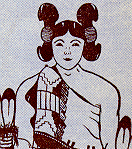 Joe M. Clark
Joe M. Clark
Guidebook of Santa Fe and Indian Pueblos
Santa Fe, New Mexico: Santa Fe Press, Inc.
1941, 24 pages
F804.S2 G9
Pam. Partial pamphlet [1.9 MB]
Any visitor to Santa Fe would appreciate this informative guidebook, complete with a brief history, numerous advertisements, points of interest, available recreation, and a special feature of New Mexico's 17 Indian Pueblos. Visitors are provided with directions and highlights for each pueblo, warned about taking pictures without permission, and informed that although "few Indians are talkative...they enjoy seeing white visitors even more than the visitors enjoy seeing them."
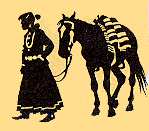 Arizona Department of Economic Planning & Development
Arizona Department of Economic Planning & Development
Meet Arizona's Indians
Phoenix, Arizona: Carey Colorgraphic Corporation
Circa 1980, 1 folded sheet
Vertical File Indians--Arizona--Indians Partial pamphlet [1.9 MB]
"Arizona, Rich in Indian Culture and Lore" reads the caption that advertises this beautifully illustrated full page lithograph of Arizona Indians, featuring over 14 different tribes and their ancient pottery types, 19 reservations, national monuments and cliff dwellings.
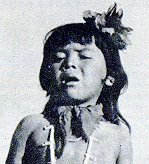 Atchison, Topeka and Santa Fe Railway
Atchison, Topeka and Santa Fe Railway
Land of the Pueblos Northern New Mexico
1958, 1 folded sheet
F802.S4 Pam. Partial pamphlet [1.7 MB]
This attractive brochure promoted by the Santa Fe Railway offers the traveler an opportunity to experience various scenic and historical attractions through Indian country by special motor cruises provided by Indian-Detours Transportation Company. No trip would be complete without seeing the amazing prehistoric cliffs and cave dwellings or visiting famous Pueblo villages where Indians dressed in primitive costume and performed ceremonial dances and rituals. Besides, "an Indian-detour is like exploring a new land with a friend who knows it well."
 Denver and Rio Grande Railroad
Denver and Rio Grande Railroad
Beautiful Historical Taos, A
Wonderland for Tourists
Denver: Smith Books Press
Circa 1920s, 12 pages
F804.T2 B4 Pam. [2.1 MB]
Any tourist would be enchanted by the Taos described in this booklet, famous for its beauty, scenery, historical interest, artist colony and indigenous culture. The promoter, Denver and Rio Grande Railroad, invites tourists to enjoy Taos' wonderful climate, recreational activities, and visit the historical Indian Pueblo. "Here three races, three languages and three civilizations" meet annually for the Taos Pueblo Fiesta of San Geronimo. Here tourist can witness the gathering of Indians, Mexicans, and Americans participating in an ancient lively, colorful event, "an Indians' old-time Harvest Festival, celebrated long before the Spanish Conquistadors set foot on New Mexican Soil".
Introduction | Accessibility | Advertising | Agriculture | Architecture | Entertainment | Environment
Exotic | Health | Indigenous Culture | Railroads | Religion | Roads
